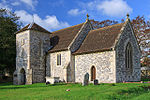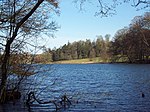Great Ridge Wood

Great Ridge Wood, formerly also known as Chicklade Wood, is one of the largest woodlands in southern Wiltshire, England. Mostly within the parishes of Boyton and Sherrington, and entirely within the Cranborne Chase and West Wiltshire Downs Area of Outstanding Natural Beauty, it lies on a chalk downland ridge above the River Wylye. To the south are the villages of Chicklade and Fonthill Bishop, while to the north are Boyton, Corton, Sherrington and Stockton. To the east of the wood, on the same ridge, lies another large block of woodland, Grovely Wood. A Roman road runs from east to west through the centre of the wood, and it has two ancient monuments within it. In recognition of its nature conservation importance, the wood is designated by Wiltshire Council as a County Wildlife Site.
Excerpt from the Wikipedia article Great Ridge Wood (License: CC BY-SA 3.0, Authors, Images).Great Ridge Wood
Geographical coordinates (GPS) Address Nearby Places Show on map
Geographical coordinates (GPS)
| Latitude | Longitude |
|---|---|
| N 51.127 ° | E -2.101 ° |
Address
Great Ridge
SP3 5SY , Boyton
England, United Kingdom
Open on Google Maps











